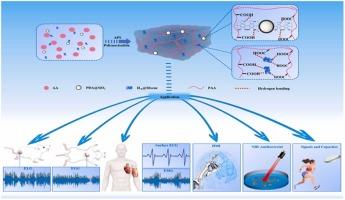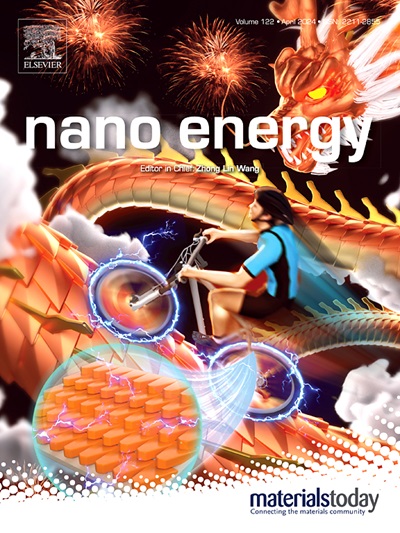具有优异分散性的自粘性 ILn@MXene 多功能水凝胶,可用于人机交互、电容器、抗菌以及检测人类和动物的各种生理电信号
IF 16.8
1区 材料科学
Q1 CHEMISTRY, PHYSICAL
引用次数: 0
摘要
MXene 在水凝胶中的分散性较差,这削弱了柔性传感器的灵敏度和循环稳定性。在这项工作中,我们采用不同链长(C=4、8、12、16、18)的离子液体(IL)来调节 MXene 的层间间隔。结果发现,链长为 C=16 的 ILn 在插层过程中引起的层间距变化最为显著,可有效抑制 MXene 的自堆叠并防止其聚集。基于这一发现,我们开发出了具有聚丙烯酸(PAA)网络和聚多巴胺涂层二氧化硅(PS)的 A-PS-0.06I16@M 水凝胶。制成的水凝胶具有高拉伸性、粘附性和导电性,并表现出优异的机械性能,包括高达 1903% 的拉伸性、20 kPa 的弹性模量和 806 kJ-m-3 的韧性。该水凝胶具有卓越的导电性(14.8 mS-cm-1)和高灵敏度(GF=7.64),这些特性使其在监测人体运动信号、心电图(ECG)、肌电图(EMG)和大鼠电信号方面尤为有效。此外,这种水凝胶在人机界面(HMI)、808 纳米近红外线照射下的电容器和抗菌效果方面也表现出巨大的潜力,这表明它在柔性电子、传感器和生物医学工程方面具有广泛的应用前景。本文章由计算机程序翻译,如有差异,请以英文原文为准。

Self-Adhesive ILn@MXene multifunctional hydrogel with excellent dispersibility for human-machine interaction, capacitor, antibacterial and detecting various physiological electrical signals in humans and animals
The poor dispersion of MXene in hydrogel weakens the sensitivity and cycling stability of flexible sensors. In this work, we regulated the interlayer spacing of MXene by employing ionic liquids (IL) with varying chain lengths (C=4, 8, 12, 16, 18). It was found that the ILn with a chain length of C=16 caused the most significant change in interlayer spacing during intercalation, effectively inhibiting the self-restacking of MXene and preventing its aggregation. Building on this finding, we developed the A-PS-0.06I16@M hydrogel with a polyacrylic acid (PAA) network and polydopamine-coated silica (PS). The fabrication of a highly stretchable, adhesive, and conductive hydrogel, exhibited excellent mechanical properties, including up to 1903 % stretchability, elastic modulus of 20 kPa and 806 kJ·m−3 toughness. The hydrogel demonstrated superior electrical conductivity (14.8 mS·cm−1) and high sensitivity (GF=7.64), these features make it particularly effective in monitoring human motion signals, electrocardiograms (ECG), electromyograms (EMG), and electrical signals in rats. Moreover, the hydrogel exhibited great potential in human-machine interface (HMI)、capacitor and antibacterial effects under 808 nm near-infrared light irradiation,indicating broad applications in flexible electronics, sensors, and biomedical engineering.
求助全文
通过发布文献求助,成功后即可免费获取论文全文。
去求助
来源期刊

Nano Energy
CHEMISTRY, PHYSICAL-NANOSCIENCE & NANOTECHNOLOGY
CiteScore
30.30
自引率
7.40%
发文量
1207
审稿时长
23 days
期刊介绍:
Nano Energy is a multidisciplinary, rapid-publication forum of original peer-reviewed contributions on the science and engineering of nanomaterials and nanodevices used in all forms of energy harvesting, conversion, storage, utilization and policy. Through its mixture of articles, reviews, communications, research news, and information on key developments, Nano Energy provides a comprehensive coverage of this exciting and dynamic field which joins nanoscience and nanotechnology with energy science. The journal is relevant to all those who are interested in nanomaterials solutions to the energy problem.
Nano Energy publishes original experimental and theoretical research on all aspects of energy-related research which utilizes nanomaterials and nanotechnology. Manuscripts of four types are considered: review articles which inform readers of the latest research and advances in energy science; rapid communications which feature exciting research breakthroughs in the field; full-length articles which report comprehensive research developments; and news and opinions which comment on topical issues or express views on the developments in related fields.
 求助内容:
求助内容: 应助结果提醒方式:
应助结果提醒方式:


